After a heavy rain, you notice puddles lingering in your garden for over 24 hours. That’s a clear sign of poor drainage, and it can spell trouble for your plants. Check for soggy patches or yellowing leaves, as these often mean water’s trapped around roots. Let’s explore other warning signs and simple fixes, like aerating soil or raising beds, to get your garden thriving again. Curious about the next step?
Contents
Persistent Puddles
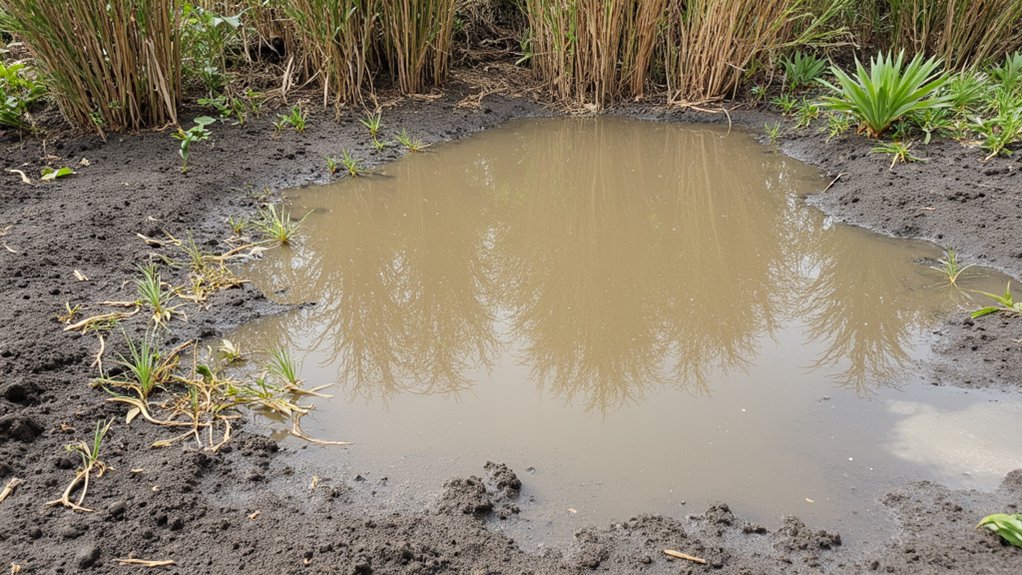
Hey, let’s talk about those pesky persistent puddles in your garden. You’ve probably noticed them lingering after rain, right? These aren’t just annoying; they signal poor drainage that can harm your plants.
Check for puddles that stick around for over 24 hours after a storm. If you’ve got water pooling longer than that, especially in flat areas, it’s a red flag. Measure the depth—anything over an inch means trouble for root health.
Now, walk your garden after rain and mark puddle spots with sticks or stones. Note the size, too; a 2-foot-wide puddle needs attention. This helps you track problem zones. Later, you can dig small test holes, about 6 inches deep, to see how water behaves there.
Soggy Lawn Patches
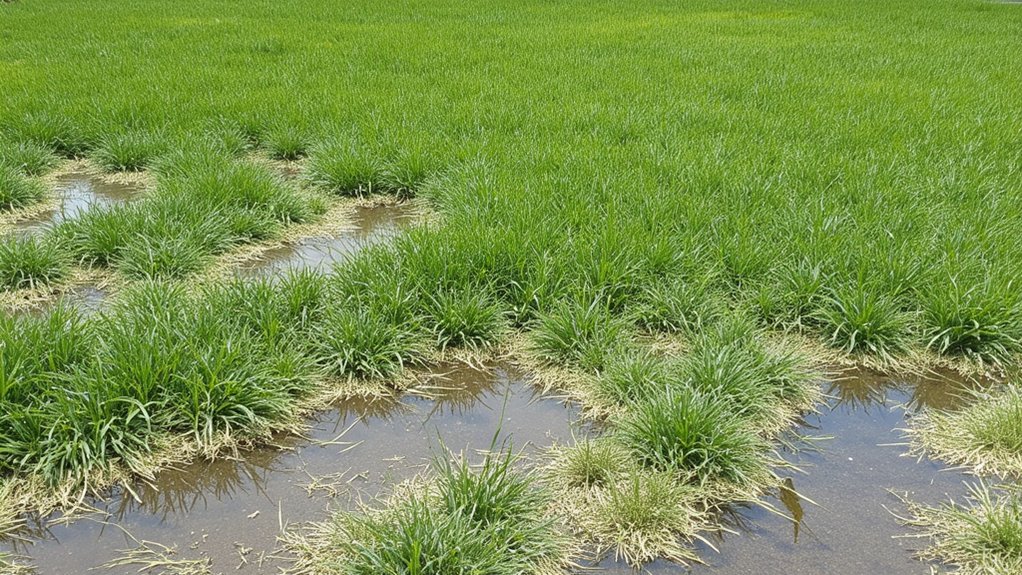
Notice those mushy spots on your lawn that just won’t firm up? They’re a clear sign of poor drainage, and you’ve gotta act fast. Walking on them feels like stepping on a sponge, right? That’s excess water trapped in the soil, often after rain.
First, check if these patches stay wet for more than 24 hours post-rainfall. If they do, mark the areas—use small stakes or string. Next, dig a small test hole, about 6 inches deep, to see if water pools there. This shows drainage issues.
To fix it, aerate the soil with a garden fork, poking holes every 4 inches. Then, add a 1-inch layer of coarse sand to help water seep through faster. Keep monitoring!
Eroding Soil Slopes
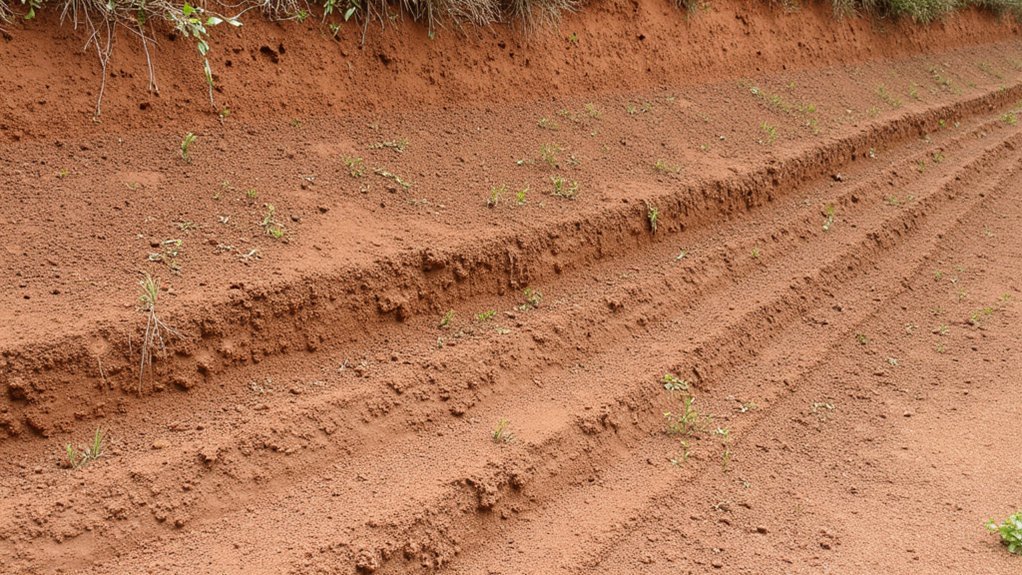
Ever spot soil washing away on a slope in your garden? That’s a clear sign of poor drainage, and you’ve gotta act fast. Erosion strips away valuable topsoil, leaving roots exposed and plants struggling.
Here’s what you can do to fix it. Start by installing a retaining wall, about 1-2 feet high, using stones or timber at the slope’s base. This’ll slow water runoff instantly. Then, plant ground cover like creeping thyme within a week; its roots grip soil tight.
Don’t ignore mulch either—spread a 2-inch layer over bare spots to shield soil from heavy rain. Check slopes after storms, too. If erosion continues, consider terracing the area in 3-foot-wide steps to manage water flow better.
Yellowing Plant Leaves
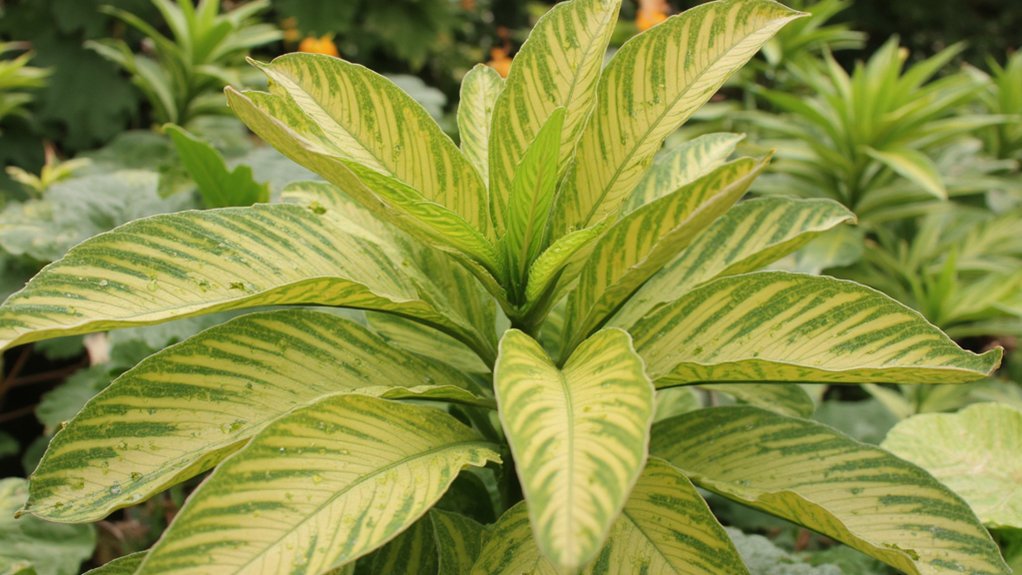
Moving from soil troubles on slopes, let’s tackle another garden issue: yellowing plant leaves. You’ve likely noticed those pale, sickly leaves in your garden. This often signals poor drainage, as waterlogged roots can’t absorb nutrients properly.
Check your soil first; if it stays soggy for over 24 hours after rain, drainage is the culprit. Don’t ignore this, or you’ll risk root rot. Start by testing a small area—dig a 12-inch deep hole, fill it with water, and time how long it drains. If it’s more than 2 hours, you’ve got a problem.
Fix it by adding organic matter, like compost, about 2-3 inches thick, to improve soil structure. Mix it in well, and watch those leaves green up soon!
Stunted Plant Growth
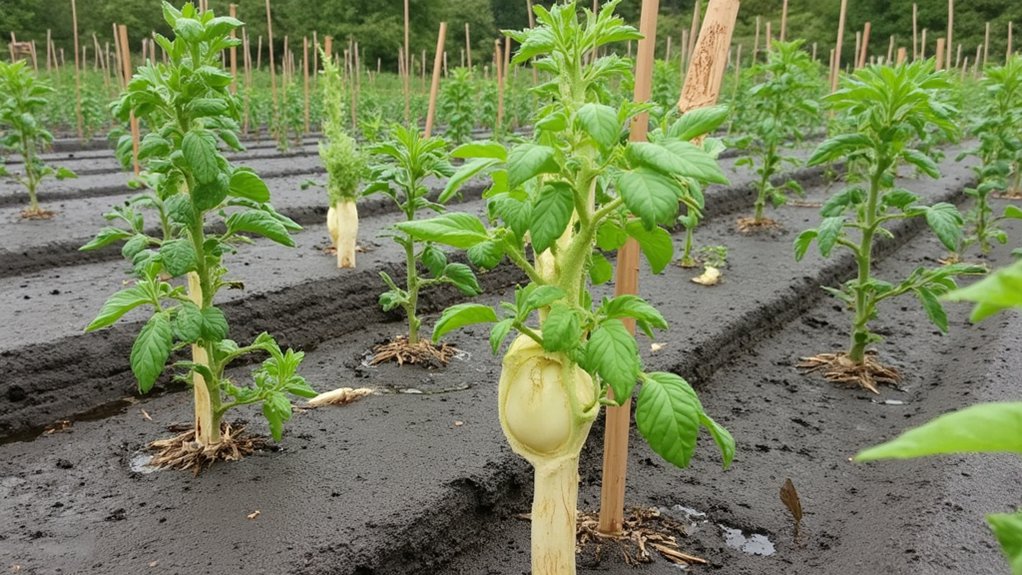
Assistant: While yellowing leaves are a clear warning, stunted plant growth is another sneaky sign of poor garden drainage. You’ll notice your plants aren’t reaching their full height, or they’re growing much slower than expected. Maybe your tomatoes are stuck at a measly 6 inches after weeks, when they should be over a foot tall by now.
This happens because soggy soil starves roots of oxygen, stunting their development. Check your garden after rain—puddles lingering over 24 hours are a red flag. To fix this, raise beds by adding 6-8 inches of well-draining soil, or install drainage tiles. Start small, test a 2-foot section, and watch your plants thrive with better airflow!
Moldy Plant Bases
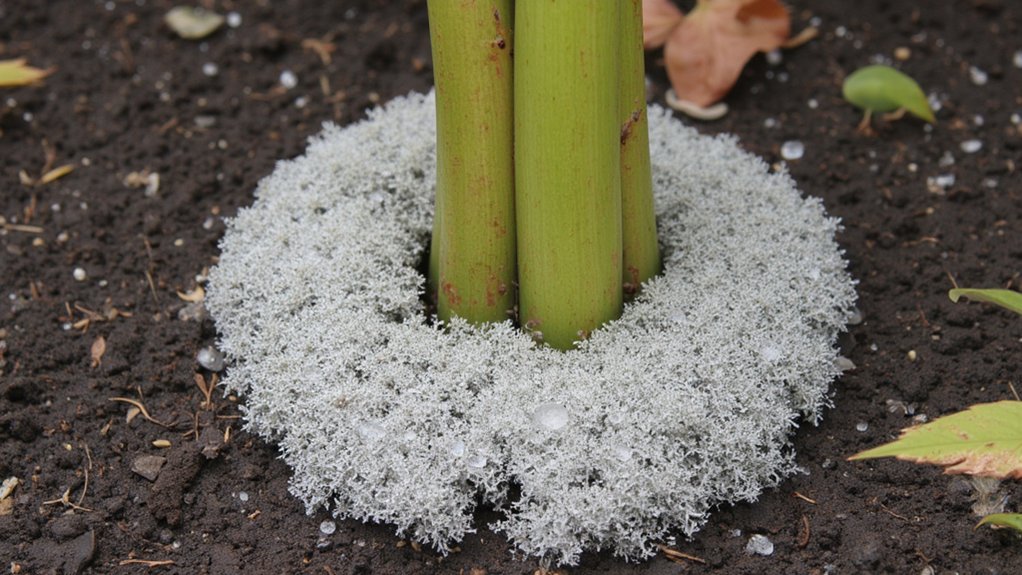
Gardeners, take a close look at the base of your plants for a sneaky issue. Moldy plant bases, often a whitish or gray fuzz, signal poor drainage. It’s a clue that moisture lingers too long around the roots.
You’ll likely spot this mold within 1-2 inches of the soil line. Check after heavy rain; if you see it, don’t ignore it. This fuzz can weaken stems, making plants prone to rot.
Waterlogged Flower Beds
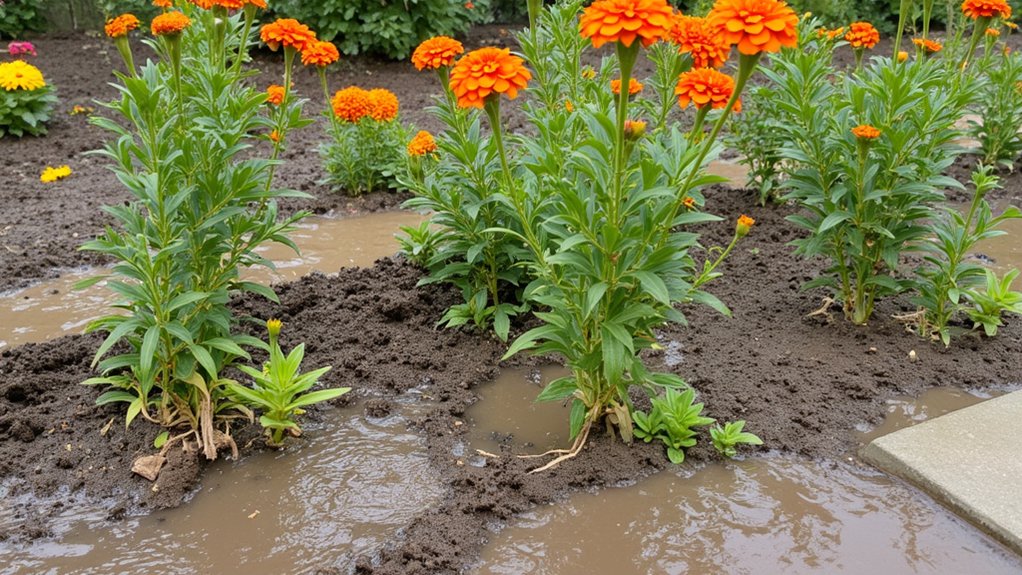
Take a stroll through your garden after a good rain, and you might notice something off. Your flower beds, those vibrant patches of color, might look more like mini swamps. If water’s pooling around your plants for over 24 hours, you’ve got a drainage issue, plain and simple.
Check the soil; if it’s soggy and sticks to your shovel like glue, that’s a red flag. Plants can’t breathe in waterlogged earth, and roots might rot within days. Start fixing this by raising your beds—add 6 to 12 inches of well-draining soil or compost on top. Then, mix in coarse sand or gravel, about 2 inches deep, to help water flow through. Keep an eye out; repeat if pooling persists.
Cracked Soil Surfaces
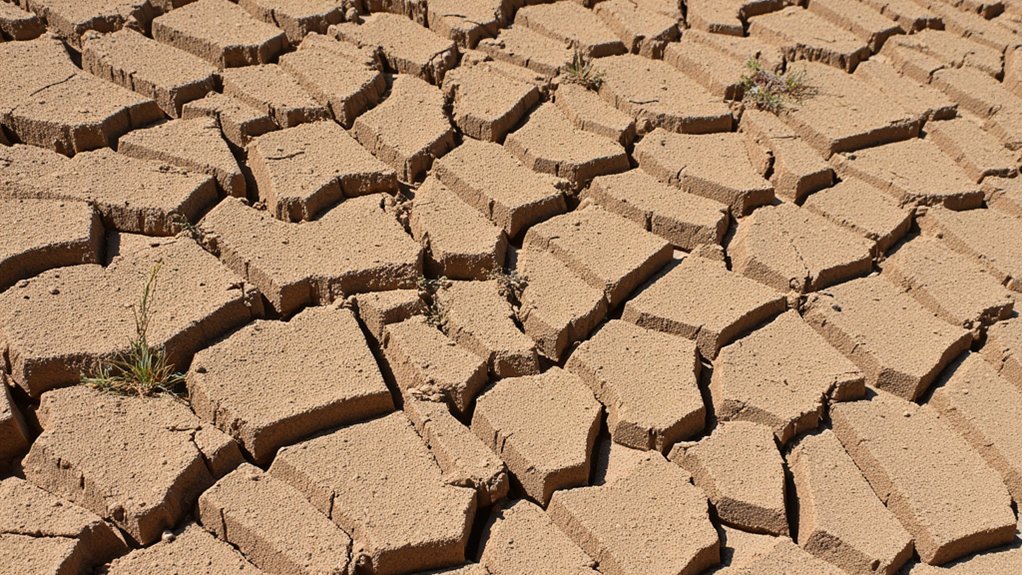
Ever noticed the soil in your garden looking like a cracked, dry desert after rain? That’s a classic sign of poor drainage, my friend. When water can’t soak in properly, it runs off, leaving the topsoil parched and split.
These cracks, often 1-2 inches deep, show that your soil compacts too tightly. Water doesn’t penetrate, so roots suffer. Check after a storm; if cracks appear within 24 hours, you’ve got a problem.
Fix it by loosening the soil with a garden fork, digging 8-12 inches deep. Add organic matter, like compost, about 2-3 inches thick, and mix it in. Water slowly over 30 minutes to test absorption. If cracks persist, repeat weekly until the soil holds together better.
Muddy Garden Pathways
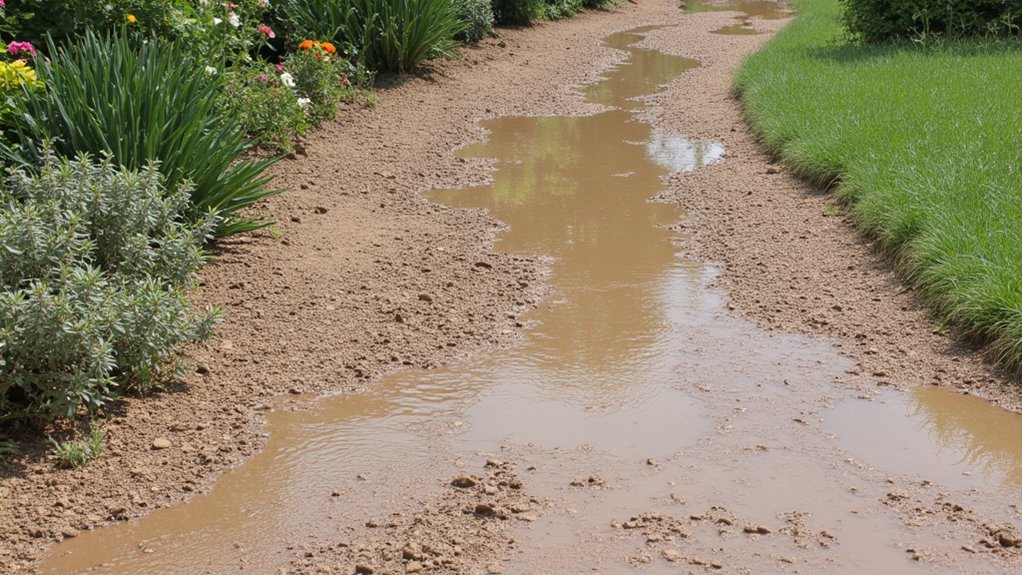
Notice how your garden paths turn into a sloppy mess after a rainstorm? You’re trudging through mud, shoes caked, and it’s a hassle. This signals poor drainage, as water isn’t soaking in or moving away properly.
Here’s what you can do to fix it. First, assess the path—look for low spots where water pools, often deeper than 2 inches after 24 hours. Next, add a layer of gravel, about 3-4 inches thick, to elevate and absorb moisture. Spread it evenly with a rake for a solid base.
If that’s not enough, consider installing a shallow trench, roughly 6 inches deep, along the path’s edge. This guides water off, keeping your walkways clear and usable.
Overflowing Rain Barrels
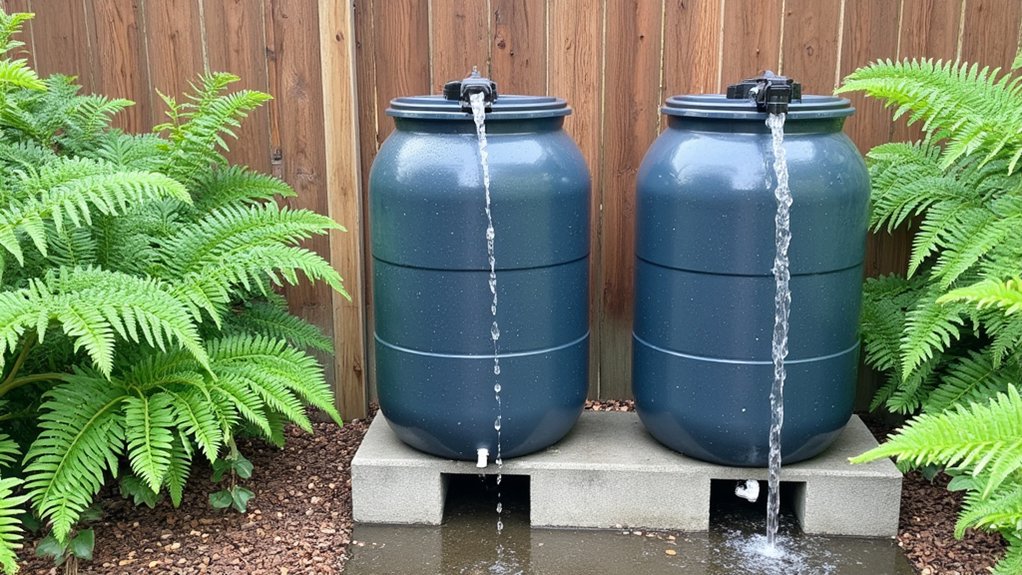
Several rain barrels brimming over after a storm can be a real clue about drainage issues. If you’ve got barrels collecting runoff, and they’re spilling over every time it rains, your garden might not be handling water well. Check the capacity—most barrels hold 50-60 gallons, so overflow means excess water isn’t draining elsewhere.
Now, take action to fix this. First, inspect nearby soil; if it’s soggy within 24 hours after rain, drainage is poor. Redirect overflow by attaching a hose to the barrel’s spout, guiding water at least 10 feet away from your garden base. Also, consider elevating barrels on a 12-inch platform for better gravity flow. These steps can prevent pooling, keeping your garden healthier.
